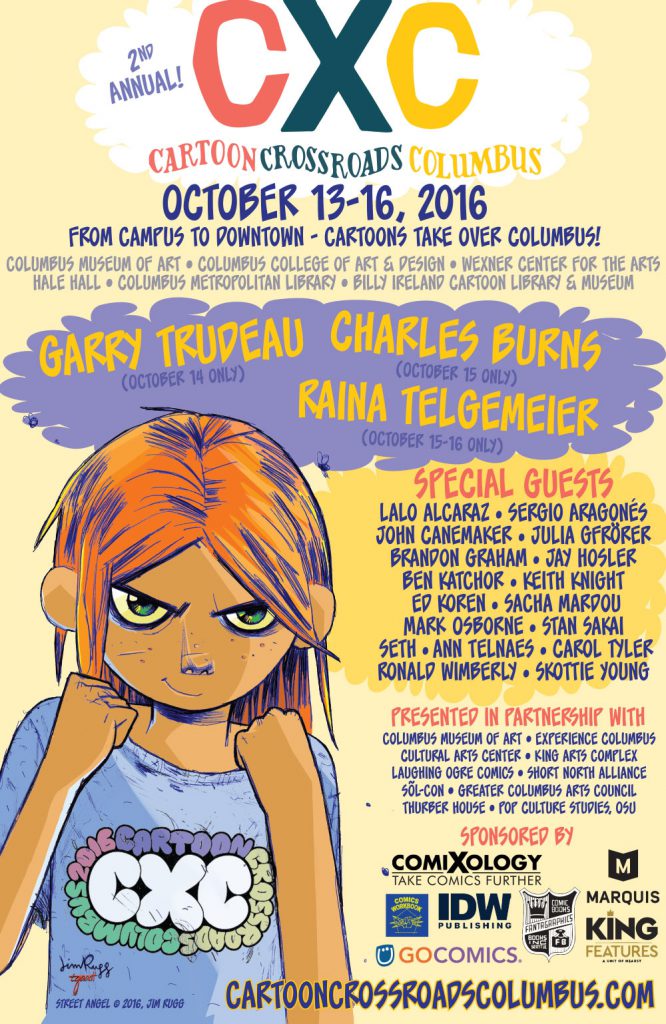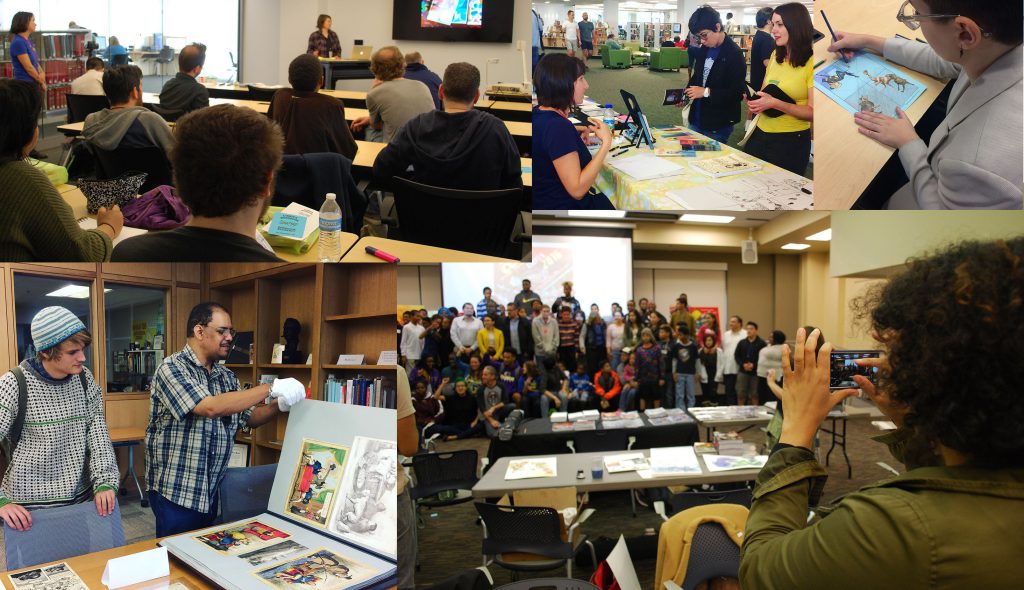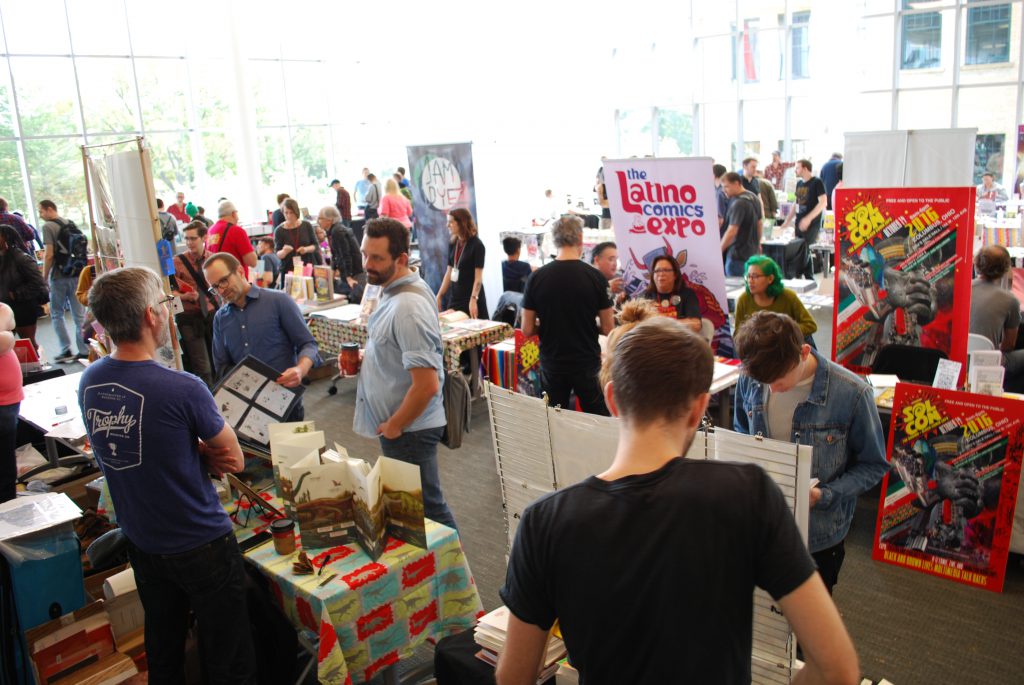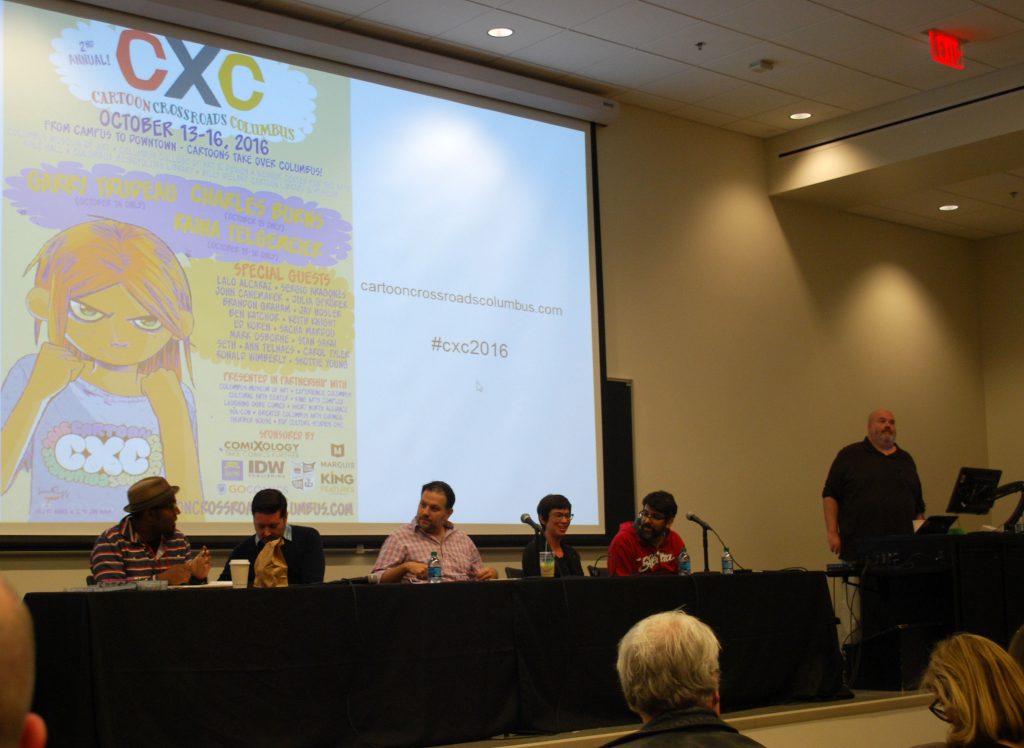
Comics Crossroads Columbus (CXC), is a 4 day long comics festival in Columbus, Ohio, that is now in its second year. Organized by comics industry professionals with a track record of both artistic contributions and service to the independent comics community, the show has largely been touted as a soon-to-be American version of France’s Angouleme; that is, a multi-day festival that explores the various facets of comics, and serves as more than just a marketplace for cartoonists, but a support of their careers and celebration of the medium.
CXC is situated in Columbus, a cozy Midwestern college town (home to Ohio State University) that is quickly building up its reputation as a “cartoonists” town due to its arts friendly institutions, reasonable cost of living, and the number of artists who have either grown up or elected to move there. Tom Spurgeon, CXC’s Festival Director, credits Columbus-native Jeff Smith, Vijaya Iyer and Lucy Caswell with the initial idea for the show, as well as Jenny Robb, Caitlin McGurk and Jared Gardner.

Caitlin McGurk, CXC committee member and Associate Curator at the Billy Ireland Cartoon Library & Museum, explained to me that planning for the first festival began in 2012. “The idea for CXC was born out of the realization that there were a significant number of institutions in Columbus paying attention to/promoting/working with comics,” she explains. “From the obvious like The Billy Ireland Cartoon Library & Museum (BICLM) and the Thurber House (James Thurber’s childhood home turned museum), to Columbus College of Art and Design (CCAD) kicking off a new comics major, to the Columbus Museum of Art hosting regular comic art exhibits (including the first US show of R. Crumb‘s Book of Genesis), and a dozen other examples, it occurred to us that few other cities have that kind of institutional power behind comics.”
The events of the first two days, held on Ohio State University’s campus, included professional development for cartoonists, tours of the BICLM, programming for young students of color through Sol-Con (a convention celebrating black and brown creators), and a scholarly symposium organized by OSU professor and CXC organizer, Jared Gardner. The weekend “marketplace” at the newly renovated Columbus Metropolitan Library, served as a small convention with exhibitors and programming, including the Comics Workbook workshop sessions. I missed checking out Ron Wimberly’s CMA Thurber House Graphic Residency as well as seeing Raina Telgemeier speak (more on this later), but I do believe that I was able to get a nice snapshot of the show.

It was one that reflected the goals of the organizers, according to McGurk – “We want it to include everyone from comic strip artists to punk mini-comics makers to political cartoonists, web cartoonists, mainstream cartoonists and the “indie” folks. Animators, too! A place where someone who has just made their first mini-comic can stand beside a MAD Magazine legend in the BICLM galleries and chat about Winsor McCay. A place to learn about developing professional skills for artists, be it from inking to legacy planning, from foreign rights to how to fill out your taxes, etc. We want to create a support system for comics, in a place that already serves as a home and shrine to comics.”
I decided to approach my write up as a “report card” absent of a final grade, but with some notes on the strengths of the show, some areas for improvement, as well as some notes concerning the future of the show.
I would like to thank the show’s Executive Committee: Tom Spurgeon, Jeff Smith, Vijaya Iyer, Kathleen Glosan, Lucy Caswell as well as Caitlin McGurk (Billy Ireland Cartoon Library & Museum), Laurenn McCubbin (CCAD), Jared Gardner, Neil Cameron, Frederick L. Aldama (Sol-Con), Comics Workbook, and countless volunteers.
Strengths & Highlights
- Versatility: Overall all, CXC’s greatest asset was its understanding that comics culture is multidimensional. The show welcomed cartoonists, comics scholars, publishers, fans, and those with specific interests within the community. It strove to be inclusive, even if it was not fully realized.
- Talk and Teach: There were two days of professional development workshops and talks before the weekend convention commenced. For those who were able to make it out, it was a wonderful way for cartoonists, who are usually stuck behind their tables at shows, to take time for themselves to learn and grow. Two highlights for me included Sacha Mardou’s long form fiction planning talk and Kriota Willberg’s Drawing with No Pain! Injury Prevention for Cartoonists workshop. Dustin Harbin, T. Edward Bak, and Ann Telnaes also led Talk and Teach workshops.

- Scholarly Symposium: In its first year, the theme chosen for this 2-day symposium was “Canon Fodder”, as the goal of the gathering was to “seek to test and remix the still-damp concrete of comics histories and canons before they set.” Chaired by OSU Professor of English (and comics scholar), Jared Gardner, the symposium was intended to bring together academics to present, learn, and open a dialogue about everything from representation in comics to who is responsible for dominant narratives. I spoke with some attendees later at the marketplace. Comics scholarship seems to be a relatively small field at this point and one that is not always directly tied into the comics industry itself. That’s why I think it was smart to include the symposium in this show. Plus, it provided academics a chance to observe small-press culture and acquire comics and graphic novels from indie artists whose work they may not have encountered otherwise.
- Billy Ireland Cartoon Library & Museum Tours: On Friday, tours were given on the hour of the archives. This provided us with a fascinating look at their vast collection, which included everything from original art, graphic novels, and manga, to fan letters written to cartoonists. Additionally, librarians selected a diverse display of original art to look at in the reading room. Upstairs was the Little Nemo:Dream Another Dream exhibit featuring contemporary artists who contributed to the Eisner-winning book from Locust Moon Press, as well as Good Grief! Children and Comics, an exhibition featuring original art from everyone from Charles Schultz and Bill Watterson, to that of the late Richard Thompson.
- Garry Trudeau Talk: Trudeau spoke with writer Glen David Gold at the Wexner Center for the Arts on Friday night. The event provided a snapshot of his cartooning career and a reflection on his work. I was most interested in their discussion about covering war in comics strips and Trudeau’s admitted struggle to fully capture the experience of those serving in the military. I was also surprised by Trudeau’s relative outsider status as a cartoonist, as he shared that he was not very involved in the comics world as an industry person or as a reader. Other notable talks at CXC included “Animator and Author John Canemaker on Windsor McCay’s Little Nemo”, “25 Years: Seth in Conversation with Ben Katchor“, Charles Burns at CCAD, and Raina Telgemeier in Conversation with Jeff Smith.

- Social Opportunities: The organizers also understood the necessity of socializing. Again, perhaps this is because many are cartoonists themselves and have an understanding of the rather solitary nature of the craft. The show provided ample opportunities to socialize beyond the marketplace, including after parties each night hosted by different cartoonists (Katie Skelly, Stan Sakai, Julia Gfrorer, and Sean T. Collins) at local bars.
- Awards: On Friday, the CXC 2016 Master Cartoonist Awards went to Carol Tyler and Sergio Aragones, honoring their bodies of work, while Garry Trudeau received the CXC 2016 Masterwork Award for Doonesbury. At the weekend’s marketplace, cartoonist and publisher, Kevin Czap was honored with the Emerging Talent Award. Discussing his award with CW presenter Alyssa Berg, Czap said “I didn’t expect it at all. It felt nice in that regard—plugging away at this thing and trying to be a part of the larger conversation of comics, which I feel a part of is being represented at CXC. So the award felt like acknowledgement, that you are being noticed and heard, which feels nice. I’m doing all of this stuff without expectation of reward, it’s just what I want to do, but it’s nice to see some traction.” In the same way that it is important to celebrate seasoned artists with “lifetime achievement awards”, supporting artists in their formative years (and even more so with funds) shows respect and appreciation for cartoonists in a unique part of their career.

- Location: Columbus was a nice choice for a comics festival given its small size, affordability, and comics foundation (including the local talent and facilities). The facilities, including those at OSU as well as the newly renovated Columbus Metropolitan Public Library, were a major asset to this show given their accessibility and presenter-friendliness.
- Hospitality and Support: Many exhibitors told me that CXC organizers and volunteers made them feel very welcome. Whether it was arrangements being made to pick up individuals from the airport or snacks made available to exhibitors, the little touches conveyed a sense of pride about the show as well as for the show’s city.
- Raina Telgemeier: As evidenced by the massive line of young girls and their families waiting in line to see her for her spotlight panel and signing of her new bestseller, Ghosts, one can assume it was a success! Seeing young, particularly female readers, develop a passion for comics is inspiring and hopeful for the medium.

Weaknesses and Room for Improvement
Tom Spurgeon was in agreement with my perception that there were some logistical flaws to this year’s show. “The big change will probably be adding a showrunner for just that day,” he elaborated. “I’d also like to add an element of shining a spotlight on 2018 in comics. I think we need to do a better job hitting our diversity goals across the board.”
- Sol-Con Omission: Let me say first that I stopped by Sol-Con’s expo and programming on Friday and was heartened by all of the black and brown school children who had been invited to learn about comics and meet cartoonists. It was clear that participants had a passion for engaging youth as well as discussing topics relevant to the black and Latino creators, publishers, and other comics professionals. The problem was that CXC’s program did not have enough specifics on Sol-Con, including locations for the weekend programming (they were available on OSU’s site for the convention). I spoke with Sol-Con’s Project Director Frederick Luis Aldama, and he told me that detailed info on the workshops had been submitted in time but were not included. He expressed that he did not believe this to be malicious, but an oversight that nonetheless upset many Sol-Con exhibitors and participants.

- Unevenness of Panels: I attended as many panels as I could, despite exhibiting. There were many highlights for me, including the Political Cartoons panel which featured Lalo Alcatraz, Nate Beeler, Keith Knight, and Ann Telneas discussing their coverage of the 2016 presidential election. There were also some less consistent panels, including the State of the Industry panel. Image’s Eric Stephenson dropped out, leaving Rich Tommaso (cartoonist), Keith Knight (cartoonist) Chip Mosher (ComiXology), Shena Wolf (GoComics.com), and Brendan Burford (King Features Syndicates) to do a syndicate-heavy panel without a print publisher present. Tom Spurgeon moderated, asking insightful and well-rounded questions, but I sensed a hesitancy to answer questions around creator incomes or anything wage-related. The panel avoided being overly negative, but tense exchanges on diversity and what being a “good artist” means in some ways reflected greater industry hot topics.
- The details: While some of CXC’s greatest successes were in its attention to detail, it’s also clear that some remain to be worked out. Issues such as not having assigned tables on an exhibitor map or the scheduling of multiple sought-after events at the same time, are worth re-visiting. I chalk this up to it being a new show more than anything else.

I’m curious to see what the future holds for this festival. I look forward to seeing what happens as comics scholarship grows and CCAD’s Comic & Narrative Major moves beyond its launch year. Given the great experiences I’ve been hearing, it seems likely that applications will go up in coming years. CXC will have to figure out what type of show its going to be, similar in some ways to what SPX is now facing. Given that its festival setup is unlike any other in this country at this point, it may not be able to rely on shows that have aged gracefully, as role models. If demand for the marketplace grows, logistics concerning lodging, transportation, and show curation will be unavoidable, as will its connections with the scholarly symposium and Sol-Con.
When I asked Spurgeon what he wanted for this festival in coming years he said he hoped that CXC would “not just [be] having a strong show but driving attention to the entire world of comics in a kind of Cannes Film Festival way.” He talked of developing a housing program as well. “I’d love for the show to become successful enough we can aim it at some of comics intractable problems!”
I truly hope the best for this show, as it left me with a homey feeling that was a testament to it’s passionate featured talent and its hardworking organizers.
—————————————————————————————————
Whit Taylor is a New Jersey-born cartoonist, editor, and comics writer. Her most recent books are Ghost and Wallpaper. She has previously reported on CAB 2014, SPX 2014, and the 2014 Comics & Medicine Conference. She lives in New York City.
—————————————————————————————————
(For more Comics Workbook CXC 2016 coverage check out our special “round up” report HERE.)